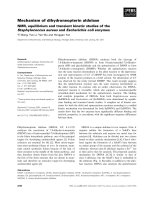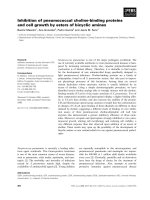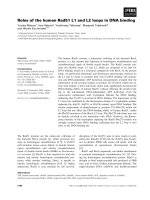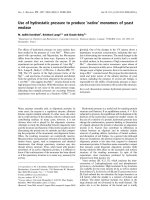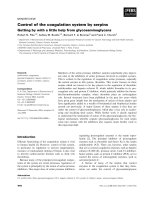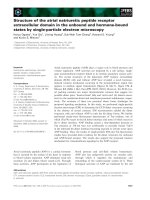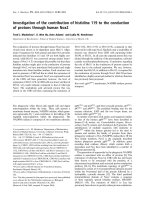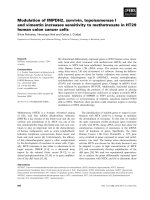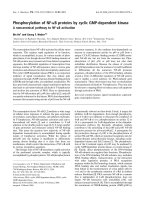Báo cáo khoa học: "Estimation of clonal contribution to cone and seed crops in a Sitka spruce seed orchard" potx
Bạn đang xem bản rút gọn của tài liệu. Xem và tải ngay bản đầy đủ của tài liệu tại đây (375.9 KB, 7 trang )
Original
article
Estimation
of
clonal
contribution
to
cone
and
seed
crops
in
a
Sitka
spruce
seed
orchard
*
K
Chaisurisri
YA
El-Kassaby
1
Faculty
of Forestry,
University
of British
Columbia,
Vancouver,
BC,
V6T
1Z4;
2
Pacific
Forest
Products
Ltd,
Saanich
Forestry
Centre,
8067
East
Saanich
Rd,
RR#1,
Saanichton,
BC,
VOS 1M0
Canada
(Received
17
November
1992;
accepted
12
May
1993)
Summary —
The
relationship
between
reproductive
energy
and
reproductive
success
and
its
impact
on
parental
balance
were
studied
in
a
clonal
Sitka
spruce
(Picea
sitchensis
(Bong)
Carr)
seed
or-
chard
over
2
crop-years.
Parental
reproductive
output
and
effective
female
population
number
esti-
mates
gave
a
good
indication
of
the
parental
imbalance
in
the
orchard
crops,
however,
they
did
not
show
the
existing
differences
in
reproductive
energy
and
reproductive
success
among
the
studied
clones.
Parental
balance
estimates
based
on
seed
data
were
more
accurate
than those
based
on
cone
counts.
The
orchard’s
parental
balance
showed
consistent
improvement
over
time.
Two
man-
agement
options,
namely,
supplemental-mass-pollination
and
harvesting
the
cone
crop
by
subsets
of
cone
production
level,
were
proposed
to
alleviate
parental
imbalance.
Sitka
spruce
I
seed
orchard
I
parental
balance
I
effective
population
number
/
reproductive
energy
/
reproductive
success
Résumé —
Estimation
de
la
contribution
clonale
à
la
production
de
cones
et
de
graines
dans
un
verger
à
graines
d’épicéa
de
Sitka.
Cet
article
étudie
les
relations
entre
énergie
reproductive
(nombre
de
cones
produits
par
un
arbre)
et
succès
reproductif
(nombre
de
graines
produites).
L’im-
pact
de
ces
2
facteurs
sur
la
contribution
de
chaque
clone
à la
production
de
graines
d’un
verger
d’épicéa
de
Sitka
durant
2 années
successives
est
également
abordé.
Les
estimations
du
nombre
efficace
d’arbres
mères
rendent
bien
compte
de
la
contribution
très
inégale
des
différents
clones
à
la
production
de
graines.
Cependant,
elles
ne
mettent
pas
en
évidence
les
différences
clonales
entre
énergie
reproductive
et
succès
reproductif.
La
contribution
relative
de
chaque
parent
basée
sur
la
production
de
graines
est
plus
précise
que
celle
basée
sur
la
production
de
cones.
L’amplitude
de
variation
de
ces
contributions
clonales
tend
à
diminuer
avec
l’âge
du
verger.
Une
alternative
à
la
*
The
manuscript
represents
a
portion
of
the
senior
author’s
Ph
D
dissertation.
**
Permanent
address:
ASEAN-Canada
Forest
Tree
Seed
Centre,
Muck-Lek,
Saraburi
18180
Thai-
land.
***
Correspondence
and
reprints
contribution
très
inégale
est
proposée :
pollinisation
complémentaire
artificielle
et
récolte
individuali-
sée
des
cones
par
classe
de
production.
épicéa
de
Sitka
/
verger
à
graines
/
contribution
parentale
/
taille
efficace
de
population
/
éner-
gie
reproductive
/
succès
reproductif
INTRODUCTION
A
seed
orchard
is
a
plantation
of
geneti-
cally
superior
individuals
managed
to
pro-
mote
their
intermating while
preventing
pollen
contamination
(Zobel
et
al,
1958).
The
genetic
value
and
diversity
of
orchard-
produced
seeds
are
expected
to
be
high
throughout
successive
generations.
Sever-
al
biological
conditions
are
required
for
seed
orchards
to
meet
these
objectives.
These
are:
1)
parental
balance
(ie,
equal-
ity
of
male
and
female
gametes
among
the
orchard
clones);
2)
reproductive
pheno-
logy
synchrony;
3)
random
mating;
4)
no
incompatibility
and
selection
between
fertil-
ization
and
germination;
and
5)
minimal
or
no
pollen
contamination
(Eriksson
et
al,
1973).
However,
it
is
commonly
observed
that
seed
orchards
often
deviate
from
their
"ideal"
expectations
(see
El-Kassaby,
1989,
for
review).
For
example,
differences
in
reproductive
output
have
been
reported
for
several
species
(Eriksson
et
al,
1973;
Jonsson
et
al,
1976;
O’Reilly
et
al,
1982;
Schmidtling,
1983;
Griffin,
1982;
Bryam
et
al,
1986;
Schoen
et
al,
1986;
Askew,
1988;
El-Kassaby
et al,
1989;
El-Kassaby
and
Reynolds,
1990;
Boes
et al,
1991;
Ro-
berds
et al,
1991).
Thus,
the
genetic
repre-
sentation
of
the
orchard’s
clones
varies
in
the
seed
crop.
Parental
balance
of
seed
orchard’s
crops
is
commonly
summarized
by
cone-
yield
curves
(Griffin,
1982).
In
this
method
the
seed
orchard’s
clones
are
ranked
from
high
to
low
yield
and
cumulative
percent-
age
calculations
are
plotted
against
the
percentage
of
clones
counted.
With
this
presentation
the
percent
contribution
of
any
proportion
of
clones
to
the
cone
crop
can
easily
be
estimated.
The
concept
of
ef-
fective
population
number
also
can
be
used
to
demonstrate
the
deviation
from
the
idealized
case
(ie,
equal
contribution;
Fal-
coner,
1986).
The
effective
number
of
a
natural
population
is
always
expected
to
be
less
than
the
number
of
adults
of
repro-
ducing
age
for
one
or
more
reasons:
1)
un-
equal
numbers
of
males
and
females;
2)
temporal
variation
in
population
number;
and
3)
greater
than
binomial
or
Poisson
variability
in
the
number
of
progeny
per
plant
(Crow
and
Kimura,
1970;
Crow
and
Denniston,
1988).
The
use
of
cumulative
yield
curves
or
effective
population
number
based
on
seed-cone
count
assumes
that
repro-
ductive
energy
(ie,
number
of
seed-cones)
is
equal
to
reproductive
success
(ie,
num-
ber
of
filled
seeds
per
cone).
Reynolds
and
El-Kassaby
(1990)
used
cumulative
seed-
crop
data
to
assess
parental
balance
in
a
Douglas
fir
seed
orchard,
and
found
the
cumulative
seed-yield
curve
is
a
better
parameter
than
cone-yield
in
assessing
pa-
rental
balance
with
respect
to
(in
terms
of)
genetic
diversity
and
family
representation.
This
study
was
conducted
to:
1)
con-
trast
methods
of
evaluating
parental
bal-
ance
and
female
effective
population
num-
ber;
2)
determine
parental
imbalance
in
this
orchard;
and
3)
contrast
parental
im-
balance
over
years.
MATERIALS
AND
METHODS
The
study
was
conducted
in
the
Pacific
Forest
Products
Ltd
Sitka
spruce
seed
orchard.
The
or-
chard
is
locoated
in
Saanichton,
British
Colum-
bia
(latitude
48°35’N,
longitude
123°24’W)
and
consists
of
139
clones
(averaging
9.3
ramets
per
clone)
selected
from
elevations
between
0
and
415
m
on
western
Vancouver
Island,
Wash-
ington
and
Oregon.
The
orchard
was
estab-
lished
in
1971
in
a
random
single-tree
mix
over
3
unequal
blocks.
Trees
are
spaced
3
m
apart
and
kept
at
approximately
4
m
in
height
by
top-
pruning.
The
seed
orchard
is
10
km
away
from
the
nearest
Sitka
spruce
stand,
so
Sitka
spruce
background
pollen
is
considered
to
be
negligi-
ble.
During
1988
and
1990
harvests,
the
cone
crop
of
every
clone
in
the
seed
orchard
was
counted
to
determine
the
parental
balance
for
these
2
yr.
In
this
study,
cones
were
collected
from
96
ramets
of
22
clones
(1988
crop)
and
142
ramets
of
18
clones
(1990
crop).
The
sam-
pled
(ie,
studied)
clones
were
randomly
selected
from
the
seed
orchard.
Where
possible,
a
sam-
ple
of
5
cones
was
randomly
taken
from
each
ramet
for
seed
extraction.
Cone
samples
were
air
dried,
and
seeds
were
extracted,
dewinged
and
cleaned
by
hand.
Numbers
of
filled
and
empty
seeds
(identified
by
X-ray)
were
record-
ed.
Total
seed
yields
were
assessed
for
the
1990
crop.
Individual
clone’s
average
seed
weight
was
determined
using
weight
data
from
100
indi-
vidual
seeds
per
ramet
within
every
clone,
then
the
total
seed
crop
count
was
calculated
by
di-
viding
bulk
seed
weight
of
each
ramet
within
every
clone
by
the
corresponding
average
indi-
vidual
seed
weight.
In
addition,
germination
tests
were
conducted
to
provide
viable
seed
pro-
duction
data.
Germination
test
description
was
reported
elsewhere
(Chaisurisri
et al,
1992).
One-way
ANOVA
was
used
to
analyze
the
seed
and
cone
counts
of
1988
and
1990
crops.
Due
to
a
close
relationship
among
total
seeds
(r=
0.81,
P <
0.01), filled
seeds
(r
= 1.00,
P <
0.01),
and
viable
seed
data,
filled
seed
data
only
were
used
in
the
analysis.
The
relationship
be-
tween
clonal
cone
and
seed
crops
was
as-
sessed
by
Pearson’s
product-moment
correla-
tion.
Data
on
cone,
total
seeds,
filled
seeds,
and
viable
seed
productions
were
used
to
estimate
the
female
effective
population
number
(Nef
)
(Crow
and
Kimura,
1970,
p
324):
where
N
ef
= female
effective
population
number;
xi
=
proportion
of
ith
clone
contribution
to
the
or-
chard’s
crop.
RESULTS
AND
DISCUSSION
The
randomly
selected
clones
for
1988
and
1990
were
representative
samples
of
the
production
range
in
the
seed
orchard
(fig
1),
indicating
that
the
sampled
clones
will
provide
an
unbiased
estimate
of
cone
and
seed
yield
for
the
whole
orchard.
The
relationships
between
seed-cone
and
filled-seed
production
was
positive
and
sig-
nificant
for
both
1988
(r =
0.86,
n
=
22,
P <
0.01)
and
1990
(r = 0.81,
n
= 18,
P<0.01)
crops.
The
coefficients
of
determination
were
high
for
1988
(r
2
= 0.75)
and
1990
(r
2
= 0.66)
crops,
indicating
that
the
rela-
tionship
between
cone
and
seed
accounts
for
a
large
proportion
of
variation
in
the
data.
Clonal
differences
accounted
for
34-
41 %
of
total
variation
in
cone
and
seed
crops
over
the
2
crop-years
(table
I).
Thus,
broad-sense
heritability
for
reproductive
traits
in
this
study
ranged
from
0.34
to
0.41
indicating
moderate
genetic
control.
The
remaining
variation
(59-66%)
resided
with-
in-clone
(ie,
among
ramets
within
clones).
A
change
in
yield
rank
between
cone
and
seed
indicated
that
reproductive
energy
and
reproductive
success
differed
among
clones
for
both
1988
and
1990
crops
(figs
2
and
3).
The
1988
crop
showed
that
6
out
of
22
studied
clones
(ie,
27%)
(No’s
36,
124,
53,
27,
71
and
184)
maintained
the
same
rank
as
cone
and
seed
producers
while
only
4
out
of
18
clones
(ie,
22%)
(No’s
421,
20,
411
and
416)
of
1990
crop
kept
the
same
rank
(figs
2
and
3).
Compar-
ing
the
performance
of
the
4
commonly
clones
over
the
2
crop-years
showed
that:
1)
2
clones
have
maintained
their
differential
reproductive
energy
and
output
performance
(No’s
15, 92);
and
2)
2
clones
changed
from
being
less
efficient
in
1988
to
more
efficient
or
maintained
the
same
rank
in
1990
(No’s
5
and
20,
respec-
tively).
The
proportions
of
female
effective
and
actual
numbers
(Nef
/N)
were
0.45
and
0.50
for
seed-cone
and
filled-seed
crops,
re-
spectively,
for
1988.
For
the
1990
crop,
these
proportions
were
0.70,
0.61,
0.59
and
0.58
for
cone,
total
seed,
filled
seed
and
viable
seed
productions,
respectively.
The
deviation
of
the
effective
population
number
from
an
ideal
population
indicates
the
presence
of
disproportional
contribu-
tion
by
the
studied
clones.
It
is
noteworthy
that
this ratio
showed
consistent
decline
over
yield
estimation
procedures
and
that
the
results
obtained
from
seeds
is
more
accurate
than
that
from
cones.
In
addition,
the
results
obtained
for
1990
were
better
than
those
from
1988,
indicating
improve-
ment
over
time.
The
parental
balance
records
for
this
seed
orchard
in
1985,
1986
and
1987
were
"20:80"
(ie,
20%
of
the
orchard’s
clones
produced
80%
of
the
total
cone
crop),
"35:80"
and
"42:80",
respectively
(El-
Kassaby
and
Reynolds,
1990).
In
this
study,
the
cone
crop
parental
balances
for
1988
and 1990
were
"42:80"
and
"48:80",
respectively,
indicating
improvement
with
age.
Similar
improvement
over
time
has
been
observed
also
for
loblolly
pine
(By-
ram
et
al,
1986),
and
Douglas
fir
(El-
Kassaby
et al,
1989).
The
results
obtained
from
the
cone-
yield
curves
and
the
female
effective
num-
ber
provided
an
indication
of
the
degree
of
deviation
from
the
ideal
equal
contribution;
however,
these
parameters
did
not
provide
an
insight
into
the
relationship
between
re-
productive
energy
and
reproductive
suc-
cess
as
shown
in
figures
2
and
3.
It
is
known
that
fecundity
is
under
genetic
con-
trol
(Jonsson
et
al,
1976;
El-Kassaby,
1989),
therefore,
certain
clones
may
con-
sistently
produce
high
or
low
seed
crops
due
to
their
genetic
predisposition.
Supplemental-mass-pollination
(SMP)
has
been
proven
to
be
a
vital
tool
for
im-
proving reproductive
success
for
Sitka
spruce
due
to
the
reproductive
phenology
displacement
between
male
and
female
strobili
(El-Kassaby
and
Reynolds,
1990).
SMP,
therefore,
could
improve
parental
contribution
as
well
as
reproductive
suc-
cess.
If
SMP
is
used
as
a
management
option
for
adjusting
parental
imbalance,
then
the
proportion
of
pollen
in
the
pollen
mixes
should
emphasize
those
clones
with
low
seed-cone
or
seed
production,
thus
their
gametes
are
over
emphasized
in
the
seed
crop
through
their
male
part.
Harvesting
the
cone
crop
into
subsets
that
consist
of
high,
intermediate,
and
poor
seed-cone
producers
may
improve
the
pa-
rental
balance
within
each
subset
to
a
level
that
might
be
better
than
harvesting
the
entire
crop
as
1
lot.
For
example,
the
1988
parental
balance
for
the
entire
or-
chard
was
"42:80".
When
this
crop
was
di-
vided
into
3
subsets,
parental
balances
ob-
served
were
"54:80",
"67:80"
and
"71:80"
for
poor, good
and
intermediate
cone
pro-
ducers,
respectively
(fig
4).
The
propor-
tions
of
female
effective
to
actual
popula-
tion
numbers
were
0.41,
0.74,
0.87
and
0.93
for
the
entire
crop
and
poor,
high
and
intermediate
cone
producers,
respectively,
indicating
improvement
of
the
parental
bal-
ance
due
to
grouping
clones
into
cone
pro-
duction
levels.
This
approach
will
produce
3
evenly
balanced
seedlots
from
that
seed
orchard.
The
use
of
these
3
seedlots
in
seedling
production
will
provide
a
change
to
produce
genetically
balance
seedling
crops.
In
conclusion,
the
present
study
has
demonstrated
the
following:
1)
clonal
differ-
ences
in
reproductive
energy
and
repro-
ductive
success
exist
in
Sitka
spruce;
2)
reproductive
traits
are
under
moderate
genetic
control;
3)
the
determination
of
pa-
rental
contribution
to
seed
crop
should
be
conducted
on
a
yearly
basis;
4)
parental
balance
has
improved
with
age;
and
5)
SMP
and/or
harvesting
the
cone-crop
by
subsets
of
cone
production
level
are
possi-
ble
options
for
improving
clonal
represent-
ation
in
seed
crops.
ACKNOWLEDGMENTS
The
authors
thank
MD
Meagher,
DGW
Edwards
and
SA
Barnes
for
reviewing
the
manuscript
and
KP
Brady
for
technical
assistance.
This
study
is
supported
in
part
by
ASEAN-Canada
Forest
Tree
Seed
Centre
(CIDA)
grant
to
KC
and
Pacif-
ic
Forest
Products
Ltd.
REFERENCES
Askew
GR
(1988)
Estimation
of
gamete
pool
compositions
in
clonal
seed
orchards.
Silvae
Genet
37,
227-232
Boes TK,
Brandle JR,
Lovett
WR
(1991)
Charac-
terization
of
flowering
phenology
and
seed
yield
in
a
Pinus
sylvestris
clonal
seed
orchard
in
Nebraska.
Can
For Res
21,
1721-1729
Bryam
TD,
Lowe
WJ,
McGriff
JA
(1986)
Cloncal
and
annual
variation
in
cone
production
in
loblolly
pine
seed
orchards.
For Sci 32,
1067-
1073
Chaisurisri
K,
El-Kassaby
YA,
Edwards
DGW
(1992)
Genetic
control
of
seed
size
and
ger-
mination
in
Sitka
spruce.
Silvae
Genet
41,
348-355
Crow
JF,
Denniston
C
(1988)
Inbreeding
and
variance
effective
population
numbers.
Evo-
lution
42
(3),
482-495
Crow
JF,
Kimura
M
(1970)
An
Introduction
to
Population
Genetic
Theory.
Happer
&
Row
Publ,
NY,
591
p
El-Kassaby
YA
(1989)
Genetics
of
Douglas-fir
seed
orchards:
expectations
and
realities.
In:
Proc
20th
Southern
Forest
Tree
Improve-
ment
Conference,
87-109.
Charleston,
SC
El-Kassaby
YA,
Fashler
AMK,
Crown
M
(1989)
Variation
in
fruitfulness
in
a
douglas-fir
seed
orchard
and
its
effect
on
crop
management
decisions.
Silvae
Genet 38, 113-121
El-Kassaby
YA,
Reynolds
S
(1990)
Reproduct-
ive
phenology,
parental
balance,
and
supple-
mental
mass
pollination
in
a
Sitka-spruce
seed
orchard.
For
Ecol
Manage
31,
45-54
Eriksson
G,
Jonsson
A,
Lindgren
D
(1973)
Flow-
ering
in
a
clone
trial
of
Picea
abies
Karst.
Stud
For
Suec
110,
1-45
Falconer
DS
(1986)
Introduction to
Quantitative
Genetics.
Longman
Sci
&
Tech,
NY,
2nd
ed
Griffin
AR
(1982)
Clonal
variation
in
radiata
pine
seed
orchards:
I.
Some
flowering,
cone
and
seed
production
traits.
Aust
J
For
Res
12,
295-302
Jonsson
A,
Ekberg
I,
Eriksson
G
(1976)
Flower-
ing
in
a
seed
orchard
of
Pinus
sylvestris
L.
Stud
For
Suec
135, 1-38
O’Reilly
C,
Parker WH,
Barker
JE
(1982)
Effect
of
pollination
period
and
strobili
number
on
random
mating
in
a
clonal
seed
orchard
of
Pi-
cea
mariana.
Silvae
Genet 31,
90-94
Reynolds
S,
El-Kassaby
YA
(1990)
Parental
bal-
ance
in
Douglas-fir
seed
orchard
cone
crop
vs
seed
crop.
Silvae
Genet 39,
40-42
Roberds
JH,
Friedman
ST,
El-Kassaby
YA
(1991)
Effective
number
of
pollen
parents
in
clonal
seed
orchards.
Theor
Appl
Genet
82,
313-320
Schmidtling
RC
(1983)
Genetic
variation
in
fruit-
fulness
in
a
loblolly
pine
seed
orchard.
Silvae
Genet
32,
76-80
Schoen
DJ,
Denti
D,
Stewart
SC
(1986)
Strobi-
lus
production
in
a
clonal
white
spruce
seed
orchard:
evidence
for
unbalanced
mating.
Sil-
vae
Genet 35,
201-205
Zobel
BJ,
Barber
J,
Brown
CL,
Perry
TO
(1958)
Seed
orchards.
Their
concept
and
manage-
ment.
J
For
56,
815-825
